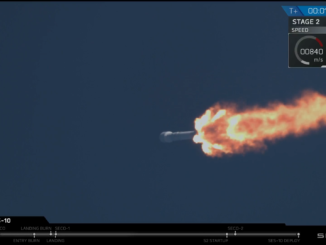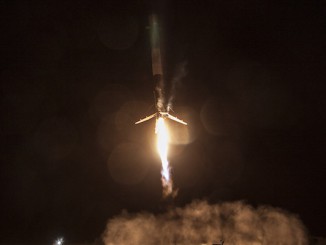
SpaceX launched 60 more Starlink satellites Wednesday into a sunny sky over Florida’s Space Coast, adding more capacity and coverage to the company’s commercial broadband network while setting new records for the pace it is reusing Falcon 9 rocket boosters.
The two-stage launcher fired its nine Merlin 1D main engines and climbed away from pad 39A at NASA’s Kennedy Space Center at 8:02 a.m. EST (1302 GMT) Wednesday. The rocket’s guidance system steered the 229-foot-tall (70-meter) launcher toward the northeast over the Atlantic Ocean on a trajectory to place the 60 Starlink relay stations into an orbit ranging between 53 degrees north and south latitude.
The first stage booster — designated B1051 — made its eighth trip to space and back on Wednesday’s mission, making it SpaceX’s fleet-leader. The first stage shut down and separated from the Falcon 9 second stage around two-and-half minutes into the flight, extended aerodynamic grid fins, and briefly arced into space before re-entering the atmosphere and nailing a propulsive landing on SpaceX’s floating recovery vessel in the Atlantic Ocean.
Braving stiff winds, the 15-story rocket descended to the landing platform, or drone ship, extended its four-legged landing gear, and fired its center engine in a final braking maneuver just before touchdown. The winds in the landing were stronger than durning previous rocket landings, but SpaceX elected to go ahead with the mission in hopes of gathering data on the booster’s capability to land in less-than-ideal conditions, according to Jessica Anderson, a SpaceX engineer who hosted the company’s launch webcast Wednesday.
Video from the drone ship dropped out as the rocket touched down about eight minutes after liftoff, but the live video quickly resumed, showing the scorched, soot-covered booster safely on the landing platform.
“We have landed the Falcon 9 for the eighth time,” Anderson said. “This is our life leader. What an amazing morning!”
Here’s a replay of the Falcon 9 rocket’s spectacular blastoff from the Kennedy Space Center minutes ago with 60 Starlink satellites.
Continuing coverage: https://t.co/EUVptgsLi8 pic.twitter.com/sP1W64xD7u
— Spaceflight Now (@SpaceflightNow) January 20, 2021
The booster on Wednesday’s launch first flew on SpaceX’s Crew Dragon Demo-1 mission in March 2019, when the human-rated spaceship took off on an unpiloted test flight to the International Space Station, paving the way for astronaut missions in 2020.
The first stage launched again from California in June 2019 carrying Canada’s three Radarsat Constellation Mission remote sensing satellites, then flew on four Starlink missions from Cape Canaveral. Most recently, the booster launched Dec. 13 with the SXM 7 radio broadcasting satellite for SiriusXM.
The SXM 7 launch occurred 38 days before Wednesday’s mission, marking the fastest turnaround between flights since SpaceX started reusing Falcon 9 boosters in 2017.
Elon Musk, SpaceX’s founder and CEO, has said the newest version of the Falcon 9 booster — called the Block 5 — could fly 10 times without any major refurbishment, and perhaps 100 times with periodic overhauls. With as many as 48 Falcon 9 and Falcon Heavy flights planned in 2021, SpaceX seems poised to have at least one Falcon booster, and possibly more, reach the 10-flight milestone this year.
The two halves of the Falcon 9 rocket’s payload fairing Wednesday were also recycled from previous missions. Two SpaceX fairing recovery vessels, each fitted with giant nets to catch the fairing shells as they fall under parachutes, were on station in the Atlantic Wednesday to retrieve the components.
The payload fairing jettisoned moments after ignition of the Falcon 9’s second stage engine as the rocket soared above the atmosphere, revealing the stack of 60 Starlink satellites mounted to the forward end of the rocket.

After reaching a preliminary parking orbit, the Falcon 9 upper stage coasted halfway around the world, transiting the Atlantic Ocean, Europe, and the Middle East before briefly reigniting its engine over the Indian Ocean to place the Starlink payloads in the proper orbit for deployment.
The 60 satellites released from the rocket a little more than an hour into the mission. An on-board camera showed the flat-panel satellites, built by SpaceX in Redmond, Washington, flying away from the Falcon 9 second stage.
With the 60 new satellites, SpaceX has shot 1,015 Starlink spacecraft into orbit to date, including prototypes not intended for commercial service. The new satellites will give SpaceX a fleet of around 950 Starlinks currently in orbit, after subtracting the satellites that have been deorbited, according to Jonathan McDowell, an astronomer at the Harvard-Smithsonian Center for Astrophysics who tracks global space activity.
That’s more satellites than owned any other company or government entity.
The fresh satellites will unfurl solar panels, run through automated checkouts, and activate krypton ion thrusters to begin raising their orbits to join the rest of the Starlink constellation at an altitude of 341 miles (550 kilometers).
SpaceX plans to operate an initial block of around 1,500 Starlink satellites. The company, founded by billionaire Elon Musk, has regulatory approval from the Federal Communications Commission to eventually field a fleet of up to 12,000 small Starlink broadband stations operating in Ku-band, Ka-band, and V-band frequencies.
SpaceX says the Starlink network — designed for low-latency internet service — has entered a beta testing phase in multiple U.S. states and Canada using its already-launched satellites. Testing recently expanded to the United Kingdom, SpaceX said Wednesday, and the U.S. military has also tried out the Starlink internet service.
There are also preliminary plans for an even larger fleet of 30,000 additional Starlink satellites, but a network of that size has not been authorized by the FCC.
Starlink deployment confirmed! SpaceX has now launched 1,015 Starlink internet satellites, including failed spacecraft and prototypes that have been deorbited.https://t.co/EUVptgsLi8 pic.twitter.com/2bvBRbesIm
— Spaceflight Now (@SpaceflightNow) January 20, 2021
Wednesday’s mission was SpaceX’s second launch of the year. Two more Falcon 9 flights are scheduled before the end of January.
A Falcon 9 rocket is set for liftoff from pad 40 at Cape Canaveral Space Force Station during a one-hour window opening at 9:24 a.m. EST (1424 GMT) Friday, carrying more than 100 small satellites for the U.S. government, commercial operators, and foreign customers.
The rideshare mission will deliver the satellites into a polar orbit sun-synchronous orbit more than 300 miles, or 500 kilometers, above Earth. It will be the second launch by SpaceX from Cape Canaveral to aim for a polar orbit, using a southerly launch corridor blazed by a Falcon 9 flight in August with Argentina’s SAOCOM 1B radar observation satellite.
Another Falcon 9 mission is tentatively scheduled to take off from the Florida spaceport the morning of Jan. 27 with another batch of roughly 60 Starlink satellites, according to publicly-available hazard area notice outlining offshore keep-out zones for the launch.
Email the author.
Follow Stephen Clark on Twitter: @StephenClark1.



